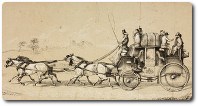Articles
- The world of Victorian writers 1837 - 1901
- Victorian writers
- Making sense of the tangible world
- Making sense of the intangible world
Travel, transport and communication
Pre 1830's limitations
Until the 1830's, the greatest distance anyone could travel in a day on land was 50-60 miles, with the aid of fast horses. By sea, in a fast sailing boat, perhaps a little more could be done. Letters were the only form of instant communication, and they could travel no faster than the fastest horse or ship.
Two events revolutionised the speed of travel:
- the railways
- the telegraph system
The rail and telegraph systems
From the 1830's a rail network spread throughout Britain, then Europe and .jpg) America. Trains could travel over 60 m.p.h., and suddenly everywhere in Britain could be reached within a couple of days. It mean that daily newspapers could be delivered the same day to towns and cities within a 200 mile radius of a city. News could now be ‘instant'. Later, the internal combustion engine (cars, buses, taxis) filled in the spaces between the rail networks.
America. Trains could travel over 60 m.p.h., and suddenly everywhere in Britain could be reached within a couple of days. It mean that daily newspapers could be delivered the same day to towns and cities within a 200 mile radius of a city. News could now be ‘instant'. Later, the internal combustion engine (cars, buses, taxis) filled in the spaces between the rail networks.
The telegraph system developed a little later, the wires following the railway tracks. This meant that people could communicate within hours, not days. Letters could also be transported by train, not taking a lot longer than telegrams, if local. The telephone system gradually took over from telegrams, but not till the 1960's did most people own a telephone.
Modern inventions
Further inventions in the twentieth century increased the speed of long-distance communication, especially
- aeroplanes
- radio and television
- the worldwide web
Aeroplanes have made international travel much quicker than the ferries and liners which could take weeks or even months to reach their destination. Travel and communicating has become significantly more affordable, shrinking the world into what is sometimes called ‘the global village'. The worldwide web of the internet has made communication possible wherever anyone is. Any news can be relayed worldwide within minutes of its being reported.
Nineteenth century novels
 Earlier nineteenth century novels, such as those by Jane Austen, the Brontës or Charles Dickens record much coach travel. Some of these slow, tiresome journeys were actually quite significant: Jane Eyre's journey of escape from Rochester leaves her symbolically stranded and lost, but she is then divinely guided in her ramble over the moors to her unknown cousins. Esther's pursuit of her mother in mid-winter up and down the Great North Road is equally dramatic and significant in Charles Dickens' Bleak House.
Earlier nineteenth century novels, such as those by Jane Austen, the Brontës or Charles Dickens record much coach travel. Some of these slow, tiresome journeys were actually quite significant: Jane Eyre's journey of escape from Rochester leaves her symbolically stranded and lost, but she is then divinely guided in her ramble over the moors to her unknown cousins. Esther's pursuit of her mother in mid-winter up and down the Great North Road is equally dramatic and significant in Charles Dickens' Bleak House.
By contrast, Dickens' Dombey & Son and Hard Times both depict railway journeys. There are still pursuits but bad news now keeps pace with the guilty parties. The railway provided an important plot device and the space of stations and carriages were utilised for dramatic effect. In Dombey and Son, published in monthly parts between 1846 and 1848, the ‘railway mania' that spread through Britain in the mid-nineteenth century is described:
Thomas Hardy's novels also start with coach travel, but end with railway travel in Jude the Obscure. Hardy uses railway speed to symbolise the rapid disintegration of stable traditional communities into anonymous personal isolation and fracture.
Modern examples
Twentieth century writers pick up on Hardy's theme of the disintegration of stability:
- Train journeys take on symbolic force, often of flight or loss of direction or control, such as in the novels of E.M.Forster, D.H.Lawrence and Virgina Woolf
- Air travel is often used similarly in more modern writers. At the beginning of Lord of the Flies, William Golding uses an air-crash just as Daniel Defoe used a shipwreck at the beginning of Robinson Crusoe. However, the boys are unable to control their environment, whilst Robinson can
- The rapid growth of Science Fiction is largely due to the increased possibility of space travel. The early twentieth century writer, H.G.Wells, was one of the first British novelists to exploit such possibilities, as well as of time travel.
